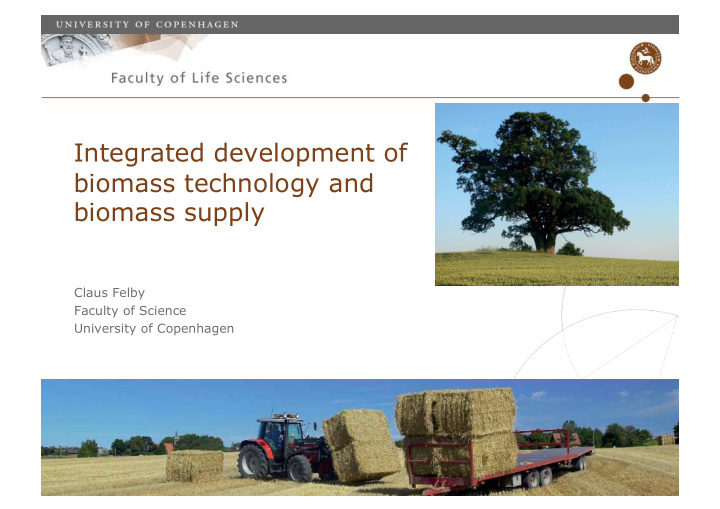



Integrated development of biomass technology and biomass supply Claus Felby Faculty of Science University of Copenhagen
This presentation is about the infrastructure and technology development when building a biorefinery sector in Denmark
…in the state of Denmark • Renewables accounts for 27% of the energy supply (66% is from Waste biomass) Straw • Current use of biomass 8 mill Wood tons/year Biogas • By 2050 100% renewable energy • Biomass is expected to take up 20-30% of the Energy supply • Biomass is an obvious choice for backup of fluctuating solar and wind. But the transportation sector needs liquid fuels. • Biorefineries are attractive because of flexibility and (hopefully) economy
Biomass in a 100% renewable energy supply Heat and power 2G Biogas bioethanol Utility gas Biomass Transport fuels Gasifiers & CHP Feed & Plant nutrients Technology Biology
Danish agriculture and forestry • No idle land • Current production of biomass ca. 30 mill tons • Mainly agriculture • 85% is used for animal feed • 20 mill tons surplus of manuer • Surplus of straw • Large import of wood • Basic strategy: Expansion of biomass use to be based on current agriculture and forestry, with no reduction in food/feed production
Biomass: Straw infrastructure • Current consumption 1,6 mill tons • Almost exclusively for heat and power • Individuel 5 year contracts with farmers • Each farmer is responsible for storage and delivery • Harvested amount is not fixed • Buffer of 20% yearly consumption • But the power plants prefer wood chips and pellets
Main technologies • 2G bioethanol • Biogas • Low-temp. gassification • CHP boilers
Inbicon plant 100 tons/day Hydrothermal pretreatent combined with enzymes
Upfront proces Liquid fraction C5 (80%) Biogass/feed 225 kg/ton Hydrothermal Biomass pretreatment 160-195 C 35% DM C6 & lignin Ethanol 200 l/ton Distillers lignin 250 kg/ton Mass balances, energy in/output etc. see Bentsen et al. BioFPR 2009 521-533
High dry matter liquefaction • Pretreated wheat straw, 25-35% dry matter • 2-7 FPU/g dry matter • Gravimetric mixing • Pumpable within 4-6 hours Jørgensen et al. 2007. Biotech. Bioeng. 96:862-870
Different scales of lignocellulose liquefaction
Low temp. fluid bed gassifier • Gassification at 500-550 deg. C • Very high feedstock flexibility • Equal efficiency on wood and straw • Phosphorous can be recovered • Well suited for straw, sludge and biogas residues
New technology for MSW to biogas • Using enzymes the organic fraction of MSW can be liquified • Metal, glas and plastic are separated by simple sieves • The organic slurry is well suited for biogas production • No source sorting is necessary • Low content of metals in the final slurry
Enzymatic liquefaction of the organic fraction in household waste After cooking Enzymes: 6 hours ~95 o C Liquid fraction Solid fraction
High dry matter biomass processing -it’s different • Decreasing efficiency of enzymes at high dry matter. • NOT an effect of product inhibition • The effect caused by • Decreased water activity • Ratio of bound/unbound water • Adsorption to lignin • Bonding of cellulases to hemicellulose (lignin?) Kristensen et al. Biotech Biofuels 2:11 Selig et al. Biotech Progress DOI: 10.1002/btpr.1617 Barsberg et al. Biotech. Letters DOI: 10.1007/s1052
Enzymes prefer dislocations Polarized light image vs. CLSM of fiber and tagged endoglucanase Each image measures 238 µ m x 238 µ m
Fractionated in straw, leaves, bran Biomass convertability study of straw from 150 wheat varities Milled for pretreatment • Different locations, multiple years and hydrolysis • Effects of leaf/stem restion and silicate content Lindedam et al 2012 Biomass & Bioenergy 37 221-228
High throughput screening of biomass for bioethanol –Collaboration on rice straw needed! • Robotic system for screening of biomass • Exploitng the inherent variability of biomass for developing dedicated food/fuel crops 96-well aluminium microtiter plate Plant material grinded and Micro-scale pressurized Enzymatic hydrolysis in distributed to microtiter heating pretreatment up to 190 24 h plate by automate plant degree C in aluminium plate, material preparation system mimicking large scale pretreatment technologies
Wheat straw to ethanol -outlook Technically cellulosic ethanol • works, but economy is tight! For sale at the gas pump! • Process efficiency 65-70% • Reducing cost works, but • increasing income is better….. Higer value products of C5 and • lignin is obvious, but large markets are needed –energy products! Just burning lignin is economically • a bad option New options for lignin? •
Maabjerg Biorefinery Under construction last parts ready in 2014/2015 Input: • 400,000 tons straw • 730,000 tons manuer • 100,000 tons waste • Output • 75 mill l ethanol • 100 mill m3 methane • 140,000 tons distillers • lignin 100,000 tons biogas • fiber residue
Maabjerg technology integration Low temp gassifier Sludge • Heat CHP boiler Fiber residue • Power Lignin C6 Fermentation • Ethanol Hydrolysis Straw & separation Waste C5 Biogas Manuer • Methane MSW Full recovery of phosphorous Future: C5 to chemicals, lignin to diesel
Technology and biology challenges • Interfacing biological and thermal processing • Heterogeneous catalysis • Gettng more value out of lignin! • Better separation of organics, inorganics, sugars, lignin and protein • Understanding the biomass variation • Biomass supply • New agricultural practice • +10 mill tons plan
Recommend
More recommend